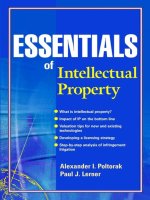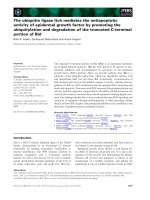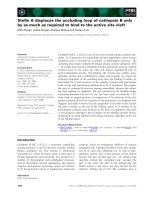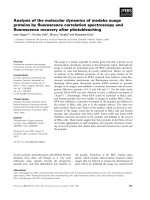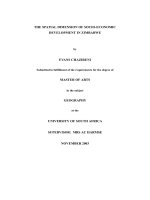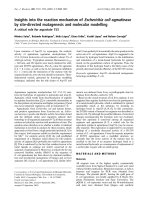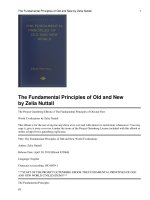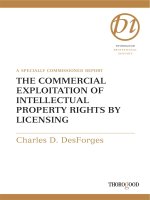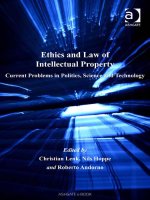THE COMMERCIAL EXPLOITATION OF INTELLECTUAL PROPERTY RIGHTS BY LICENSING docx
Bạn đang xem bản rút gọn của tài liệu. Xem và tải ngay bản đầy đủ của tài liệu tại đây (583.52 KB, 239 trang )
THOROGOOD
PROFESSIONAL
INSIGHTS
A SPECIALLY COMMISSIONED REPORT
THE COMMERCIAL
EXPLOITATION OF
INTELLECTUAL
PROPERTY RIGHTS BY
LICENSING
Charles D. DesForges
Blank page
A Thorogood Report
THE COMMERCIAL EXPLOITATION
OF INTELLECTUAL PROPERTY
RIGHTS BY LICENSING
Charles D. DesForges
Other Thorogood
Reports:
Technical Aspects of
Business Leases
Malcolm Dowden
The Competition Act –
Practical Advice and
Guidance
Susan Singleton
Published by Thorogood
10-12 Rivington Street
London EC2A 3DU.
t: 020 7749 4748
f: 020 7729 6110
e:
w: www.thorogood.ws
© Charles D. DesForges 2001
All rights reserved. No part of this
publication may be reproduced, stored in
a retrieval system or transmitted in any form
Techniques of
Structuring and Drafting
Commercial Contracts
or by any means, electronic, photocopying,
recording or otherwise, without the prior
permission of the publisher.
Robert Ribeiro
Tax Aspects of Buying
and Selling Companies
Martyn Ingles
This Report is sold subject to the
condition that it shall not, by way of trade
or otherwise, be lent, re-sold, hired out or
otherwise circulated without the publisher’s
Successful Competitive
Tendering
prior consent in any form of binding or
Jeff Woodhams
and without a similar condition including
cover other than in which it is published
this condition being imposed upon
The Internet and
E-commerce
Peter Carey
The Legal Protection
of Databases
Simon Chalton
Knowledge Management
Sue Brelade and
Christopher Harman
the subsequent purchaser.
No responsibility for loss occasioned to
any person acting or refraining from action as
a result of any material in this publication can
be accepted by the author or publisher.
A CIP catalogue record for this Report
is available from the British Library.
ISBN 1 85418 285 4
Printed in Great Britain by printflow.com
About the author
Charles DesForges is Chairman of Casect Ltd and a partner of CMD Associates.
From May 1997 to October 2000 he was Executive Director of IMnI, an
international, metal mining consortium based in Paris. He was Chief Executive of
VSL (UK-based professional organisation specialising in innovation management
and investment, European/USA strategic alliances and international licensing) from
April 1993 to December 2000 and in addition he was Chairman of Royston Lead
plc from January 1996 to October 1997. During the period March 1988 to May
1996 he was Chairman of the Board and President of TII (The European
Association for Technology Transfer, Innovation and Industrial Information) with
offices in Luxembourg & Brussels. He has been an adviser to the CEC for 15 years
and since 1984 consultant to and director of a number of companies involved in
strategic innovation and international business development.
Charles was responsible for investing in early-stage innovation at 3i plc, Europe’s
leading venture capital firm, from April 1984 to March 1993, during which time
he was Managing Director of RCL (UK-USA joint venture) and 3i REL; Chief
Executive of The Research Corporation Trust; founding-director of Impel Ltd (a
3i plc and ICSTM joint venture); Chairman of Benn Research Ltd. From September
1965 to March 1984, he held senior management/director positions in technologydependent, US multinational companies (Union Carbide Corporation and
Engelhard Corporation) in USA, Belgium, France and UK and spent six years with
a UK management consultancy/contract research company (Fulmer Group), having
started his career as a sales engineer with Foseco-Minsep plc.
He has a first class honours degree in applied science (metals and materials) and
a Ph.D. (St. John’s College, University of Cambridge), receiving various academic
prizes (Mappin and Nesthill medallist) and awards (Freshgate Foundation
Scholar and British Council Young Research Scholar). In 1977 he was made a
Fellow of the Institute of Materials (serving as Vice-President, member of the
Executive Committee, chairman of the Finance/Planning Committee and Council
member). He was made Freeman of the Goldsmith’s Company and Freeman of
the City of London in 1983. Author of 100-plus papers/articles with extensive
worldwide experience in devising and presenting senior management seminars
on: business innovation finance; commercial exploitation of intellectual property
assets; international licensing; creation of strategic alliances; European/US SME
development and technology management.
Preface
This Report has been written in response to a demand for a permanent text arising
from the seminars, which I have been presenting, on the commercial exploitation
of intellectual property assets by licensing, under the auspices of Thorogood
Publishing since 1988. The theme is principally concerned with licensing as a
commercial activity, taking place within a defined legal framework, the exact
details of which will be determined by the jurisdiction in which the licensing
business is to operate. There are a number of publications dealing in depth with
the legal issues which arise from licensing and the reader is referred to them and
to the published decisions of the courts on a variety of licensing disputes for more
complete information. The references at the end of this Report in Annex 1, provide
sources for those wishing to study these topics in greater detail. I am particularly
indebted to Iain Baillie (a London-based partner in the law firm of Ladas and Parry),
who has been a continuing mine of information and an excellent teacher, providing
incisive comment on all aspects of licensing and especially on the differences
between the European and American approaches to the protection of intellectual
property rights and the regulation of licensing.
Dr John Schaefer and his colleagues at Research Corporation in Tucson, Arizona
provided many occasions to discuss the economic and financial consequences of
licensing, based on their extensive and successful experience in commercialising
academic research results over many years in the USA. Their contribution to my
education was invaluable. The support of Dr. R. J. S. Green in analysing the value
of licensing opportunities has been of great help over many years.
This Report is designed to be a reference for the executive who is concerned with
the strategic development of a business using a variety of alliance structures, so
as to develop new products, enter new markets or simply to acquire or to gain
access to new opportunities. The expert intellectual property lawyer may find the
commercial viewpoint of value in better understanding the wishes of their industrial
clients. Academic institutions wanting to explore the commercial potential of their
research activities will find guidelines enabling them to assess whether the licensing
of early stage developments is an appropriate route to the market place for their
inventions. Financiers may find that the basic principles outlined in this text will
enable them to make better informed decisions when businesses approach them
for the funding of licensing operations. The success of companies such as BTG
plc, which are solely concerned with licensing intellectual property throughout
the world, provides both encouragement and inspiration for those seeking to
identify and exploit the commercial potential of intangible assets such as patents,
designs, software, trade marks and copyright. My comments may help to guide
them on the straight and narrow path to eventual commercial success.
Contents
1
WHAT IS LICENSING?
1
Introduction .................................................................................................2
What can be licensed? ..................................................................................4
Intellectual property and associated rights ..................................................5
Types of intellectual property ......................................................................6
Forms and protection of intellectual property rights ...................................8
International and national patent issues .......................................................9
The legal basis for licensing .......................................................................15
2
3
LICENSING AND BUSINESS STRATEGY
19
Licensing as a component of business development .................................20
The costs of protection and the maintenance of rights .............................23
HOW TO IDENTIFY A LICENSOR/LICENSEE
25
Why decide on a licensing policy? .............................................................26
Where should a licensee look for an opportunity? ....................................28
What qualities must the licensee have in
order to have some hope of success? ........................................................29
Economic assessment of licensing opportunities .......................................29
What is needed to improve your chance of success? ................................32
The Can-Balance Perpetual Balancing System ............................................32
4
FINANCIAL ISSUES
39
The value of licensing opportunities ..........................................................40
Identification of licensable technology ......................................................40
Factors to consider when analysing an opportunity ..................................45
Investment theory for royalty calculations .................................................48
The taxation of intellectual property income ............................................54
5
REGULATORY FRAMEWORK
57
Intellectual property monopolies and free trade .......................................58
Competition and anti-trust laws .................................................................58
International regulations ............................................................................60
The free movement of goods/exhaustion of rights ....................................61
6
STRUCTURE AND TERMS OF
LICENSING AGREEMENTS
63
Confidentiality of documents .....................................................................64
Definitions ..................................................................................................65
Specific clauses ...........................................................................................66
Relative interests of parties to licensing agreements .................................66
Essential clauses of a licence agreement ....................................................69
7
NEGOTIATION OF LICENSING AGREEMENTS
73
A methodology for conducting licensing agreements ................................75
Negotiation strategies .................................................................................77
Negotiation tactics ......................................................................................79
How to fail without really trying ................................................................80
Checklist for preparing a licence negotiation ............................................81
8
SPECIFIC PROBLEMS THAT CAN
BE ENCOUNTERED
83
Patents ........................................................................................................84
Software ......................................................................................................85
Databases ....................................................................................................86
Brand licensing ...........................................................................................87
9
MANAGING A LICENSING OPERATION
89
Portfolio management ................................................................................90
Managing the licence agreement after its signature ...................................91
Reasons why licensing agreements fail ......................................................92
The licensing function ................................................................................93
10
TYPICAL EXAMPLES OF
LICENSING AGREEMENTS
95
Example 1:
Licence agreement for know-how provision
and technical procurement actions ...................................97
Example 2:
Licence option agreement ...............................................121
Example 3:
Licence agreement with provision for sub-licensing
to various partners in a multinational consortium ...........154
Example 4:
Patent licence agreement .................................................183
Example 5:
Sub-contract and development agreement ......................204
ANNEXES
221
Annexe 1:
References to licensing matters ........................................222
Annexe 2:
EU competition law and restrictive clauses
in licensing agreements ....................................................224
Annexe 3:
Basic clauses in a Heads of Agreement .............................228
What is licensing?
INTRODUCTION
W H AT C A N B E L I C E N S E D ?
I N T E L L E C T U A L P R O P E RT Y A N D A S S O C I AT E D R I G H T S
TYPES OF INTELLECTUAL PROPERTY
FORMS AND PROTECTION OF INTELLECTUAL PROPERTY RIGHTS
I N T E R N AT I O N A L A N D N AT I O N A L PAT E N T I S S U E S
THE LEGAL BASIS FOR LICENSING
chapter
1
THE
COMMERCIAL
EXPLOITATION
OF
INTELLECTUAL
PROPERTY
RIGHTS
Chapter 1:
What is licensing?
Introduction
Any formal definition of licensing should distinguish the legal activity, whereby
an asset belonging to one party is made available via contract for commercial use
by another party, from the acts of outright sale or distribution, assignment or loan
of intangible assets. More generally these assets consist of intellectual property
rights involving knowledge and information or reputation, representing existing
or potential parts of a business. As the word licence implies, the owner of the
asset or right, the licensor, grants permission to an independent person or
organisation, the licensee, to make or have made, to sell or to have sold and to
use products, processes and services, embodying the specific asset or right in
question, for commercial gain but without transferring the title of ownership i.e.
the owner retains control over the asset. In return for granting this permission
the owner is entitled, by way of agreement, to receive a share of the net revenue
generated by the licensee from their commercial activities. The owner can recover
the asset upon termination of the agreement. The crucial feature of licensing is
that without the owner’s permission any act by a third party which involves the
sale of goods or services based on the asset would be illegal. From this simple
principle arises the concept of infringement of the legal owner’s rights whereby
an unauthorised third party exploits the asset in question for commercial purposes.
The identification of such an act can eventually lead to the due process of the
law to redress the situation to the ultimate benefit of the owner.
The legal documents that give effect to this act of granting permission are
commonly termed licensing agreements, although it is more correct to call them
contracts, as they nearly always comprise an offer, its acceptance and a consideration. The commercial implications of this basic act of transferring responsibility
for the profitable generation of future revenue to a competent third party form
a major part of the contents of this Report.
Some questions of principle and definition have to be answered at this point so
that we can be clear as to the scope of these deliberations. How does licensing
differ from a straightforward sale or an assignment of the assets? What are the
features of a franchising deal, which might distinguish it from licensing? At its
most basic level a sale is an exchange of goods, property or services for an agreed
2
BY
LICENSING
CHAPTER
1:
WHAT
IS
LICENSING?
sum of money or credit, the transaction taking place between a willing vendor
and a purchaser, who then becomes the owner. An assignment is an absolute
transfer of ownership in a right by an owner, the assignor, to a recipient, the
assignee, and also involves the owner giving up the right to return of the asset
if the agreement is breached. Assignments have to be in writing and the document
signed by or on behalf of the assignor in the presence of witnesses. Patent
assignments require the signatures of both parties and, where co-ownership is
involved, the assignment must be signed by all owners with an interest in the
right being assigned for it to be valid. It should be pointed out that any continuing
rights in an assignment agreement can only be enforced if the assignee can still
be sued, which may prove to be a problem in some circumstances. In contrast
a licensing agreement can be terminated and the text of such an agreement will
always contain clauses detailing when and how the termination is to be effected
and how any arising actions such as recovery of information are to be executed.
Franchising, which finds its origins in the USA, has been defined in an American
dictionary as ‘the right granted to an individual or group to market a company’s
goods or services in a particular territory’ in exchange for a fee. This description
is rather limited in scope as franchises often involve third party use by a franchisee
of trade marks or service marks as well as specific plans, uniform systems and
standards plus prescribed business formats associated with the owner’s business.
The franchiser provides all this information. It is claimed that these features ensure
consistency of product and a guarantee of high quality. In essence the franchisee
is seeking to benefit from the reputation and skills which have been developed
by the franchiser and the consumer public identifies these qualities with the
franchisee. Two basic types can be identified. In the first category, that of the
business format, both a uniform identity and standard procedures are provided
thus giving to the business an appearance which is the same no matter where it
is carried out. Fast food establishments, typified by McDonald’s, are prime examples
of this variety of franchise. The second type, perhaps not so well recognised as
such, is that of a manufacturing franchise such as the bottling of carbonated drinks
using secret recipes or ingredients and trade marks to identify the product when
it is sold or distributed. The Coca-Cola bottling franchise is an excellent illustration
of the use of this principle.
3
THE
COMMERCIAL
EXPLOITATION
OF
INTELLECTUAL
PROPERTY
RIGHTS
What can be licensed?
The essence of most licensing contracts resides in intangible assets known as
intellectual property rights, which deal with information, knowledge and
reputation. The intellectual property receives legal protection either per se for
information such as patents, designs and copyright or by commercial use for
reputation rights such as trade marks. The distinguishing feature of these rights
is their bringing into existence by creative effort. It should be noted that information
can be kept confidential and by that very fact have significant commercial value
even though it has not received formal legal protection. In an ideal world it could
well be preferable to operate in total secrecy rather than to seek formal protection
for an invention with its consequential publication and the inevitable attention
of competitors. Although the substance of this Report is concerned with patents,
designs and copyrights which possess a significant technological content, it must
be recognised that there is extensive licensing, which is of immense value, in the
entertainment industry involving film, video, books and music. A further
consequence of this activity is the licensing of image associated with a wide range
of products and in particular clothing. It has been claimed that one of the most
valuable sources of income for the University of California in Los Angeles is based
on sales of sweatshirts bearing the letters UCLA! The vendor of such articles will
not normally require a licence to sell them, provided that they have been obtained
from a person such as a manufacturer who has legally acquired the related
intellectual property rights from the owner or has legitimate access to them.
The specific situation of agents, distributors and users dealing with a product in
which rights exist has to be assessed on a case-by-case basis in order to decide
whether they need a licence for their commercial activity. Typically, for example,
an agent is acting on behalf of a company and does not have title to the goods
as they are merely a ‘go between’, an interface facilitating contact between vendor
and purchaser, and it is difficult to see why they should need a licence for their
services. Distributors having title to the goods are usually only reselling them but
if repackaging is carried out and a trade mark is used then a licence for such use
may be necessary as part of the overall distribution agreement.
4
BY
LICENSING
CHAPTER
1:
WHAT
IS
LICENSING?
Intellectual property and associated rights
A simple definition of intellectual property must encompass a number of
essential features: their intangible nature, their coming into existence as a result
of creative intellectual effort producing information and knowledge of practical
utility and their creation by commercial activity thus giving rise to an identity
associated with reputation and goodwill. It is more useful if we regard them as a
system of registered and unregistered legal rights, which protect the products,
processes and reputation of their creators. Although there is often a focus on the
potential financial returns to owners i.e. personal gain, the economic justification
for granting monopoly rights for inventive disclosures is related to the general
stimulus to trade and commerce provided by their innovative use. Society at large
is the prime beneficiary of such activity with any ensuing personal wealth arising
from the monopoly judged to be of secondary interest. The basic conflict arising
between open competition and private monopoly inevitably leads to nation states
having to use legal systems and lawyers to produce equitable solutions to the many
and various problems which occur in commercial and industrial activity exploiting
these property rights.
The history of intellectual property rights
The historical origins of this type of property can be traced back to Roman times
when it was considered to be unjust for the writings of an author to be published
by another person without the owner’s consent; a clear and early indication of
the principle of copyright being recognised and having potential value. At a later
date the Venetian republic granted patent rights for acts, which we would recognise
as inventions. This approach was followed in the 16th century, in England, by
recognising industrial activity monopolies but without using the term ‘patent’,
which was to be found in the term ‘letters patent’ to describe open letters sealed
by the monarch, (patent having its root in the Latin verb ‘patere’ – to be or lie
open). These gave rights to an individual to practise a trade thus leading to new
economic activity being introduced, often from a foreign country. The Statute of
Monopolies, introduced in 1623 in England, expressly recognised that patents were
an exception to the general disapproval of monopolies insofar as a ‘true and first
inventor’ was given a 14-year monopoly right of exclusion of use by all other parties
in respect of ‘letters patent’ granted for ‘new manufactures’. In the New World
the authors of the American constitution, long before industrial activity was
envisaged and research laboratories built, gave powers to Congress which would
‘promote the progress of science and useful arts by securing …… to authors and
inventors the exclusive right to their respective writings and discoveries’. Their
foresight testifies to their wisdom although they did not distinguish between the
relative scope of and differences between writings and inventions. The industrial
5
THE
COMMERCIAL
EXPLOITATION
OF
INTELLECTUAL
PROPERTY
RIGHTS
revolution and subsequent technical changes that occurred in the 20th century
have led to significant changes in patent, design and copyright law at both national
and international level but there is still no real expectation that a common and
uniform protection system applicable to the major economic regions of the world
will be introduced in the near future. These recent developments have seen the
original term of ‘industrial property’ replaced by ‘intellectual property’ and its
application to a variety of rights such as trade marks and goodwill, which concern
reputation, copyright, designs, patents and confidential material, generally
classified as information.
Types of intellectual property
In the United Kingdom registered rights comprise the following elements: patents
for inventions, with protection lasting for 20 years from the date on which an
application is formally filed at the Patent Office; designs which are characterised
by their external appearance and (until a recent development in European
legislation, described later) can be regarded as having aesthetic qualities or in legal
terms as having features with ‘eye appeal’: the right is granted for an initial period
of five years from the application date and is renewable every five years up to a
maximum of 25 years; trade marks for names, logos, shapes and, rather
surprisingly, sounds, colours and smells: these marks are associated with a
company’s products and services and registration effectively ensures an indefinite
monopoly lifetime provided that the mark continues in use.
National variations on these basic principles for registered rights exist and they
are particularly relevant for US legislation on patents with respect to three major
features viz., the period of protection is 17 years from the date of issue of the patent
(more commonly understood as the date of grant) rather than from the date of
application; the unique reliance on the principle of the personal ‘first inventor’
rather than on the official act of being ‘first to file’ a patent application leading
to the legal concept of interference; a ‘period of grace’ which essentially allows
for public written disclosure, including a patent filing in another country, or
commercial use during a twelve-month period prior to filing an application without
destroying the ‘novelty’ of the invention. The legal implications of these points
for licensing are significant, with respect to protection being sought in the major
industrialised nations and they also impact on the total cost of obtaining and
enforcing rights in the USA where legal disputes on invention dates and the novelty
of a particular patent can be both protracted and expensive. Needless to say the
financial rewards for successful legal actions appear to justify the costs.
6
BY
LICENSING
CHAPTER
1:
WHAT
IS
LICENSING?
Copyright and design rights
Unregistered rights include both copyright and design rights for functional objects.
Copyright covers a wide range of subject matter: original artistic and literary works,
music, images, both graphic and photographic, and, of great significance for the
electronic age, computer software. The relevant definitions of qualifying copyright
works in the UK are to be found in the 1988 Copyright, Designs and Patents Act.
Some authorities believe that patent protection is more appropriate for software
and there are clear signs that this problem is likely to lead to much formal legal
argument in order to develop this particular area of intellectual property law.
Copyright comes into existence as soon as publication occurs and lasts for the
lifetime of the author plus 70 years after the end of the year of the author’s death.
As with patents it is important to determine ownership of copyright works with
two pertinent categories to be considered: employer/employee relationships,
where the work is created during the course of employment, and author/
commissioning party arrangements where assignment of copyright will be
necessary as part of the deal even though the author has been paid for their efforts.
In contrast to patents, where there can only be one patentee, independent creation
of a copyright work by more than one person is possible.
One essential point to remember is that copyright protects only the expression
of an idea not the idea itself and thus provides the crucial right of preventing
unauthorised copying of a work. The illegal copying of computer software, often
described by the colourful phrase ‘piracy’ rather than by the more accurate term
of theft, was estimated to equate to worldwide lost revenue of $12 billion in 2000.
During the editing of this text a public announcement was made of an out-ofcourt settlement in England for the infringement of copyright residing in detailed
road maps. The settlement in favour of the copyright owner was based on a
payment of £20 million, comprising a licence fee plus nominal royalties for the
300 million illegal copies that had been made and sold. Both these examples are
excellent demonstrations of the economic value of copyright, even for something
as apparently anodyne as a map. English law does not require any aesthetic or
creative quality in a copyright work but continental European laws take an
opposing view: if a copyrighted work is to receive protection then there must
be clear evidence of aesthetic merit arising from its creation.
Unregistered design rights can exist in original designs. This is defined in its legal
sense in English law as being ‘the design of any aspect of the shape or
configuration of the whole or part of an article’; this covers both external and
internal features of a design, which are tangible either in a design document or
in an article made according to the design. This is in contrast to registered designs
where the feature must be visible. There is great similarity with copyright as a
design right is automatic and does not require any form of registration, only its
7
THE
COMMERCIAL
EXPLOITATION
OF
INTELLECTUAL
PROPERTY
RIGHTS
expression in tangible form. The maximum lifetime for protection of this right
for a qualifying design is 15 years but it is limited to 10 years from the end of the
year of first sale for an article sold. This right prevents unauthorised copying of
the design (as opposed to unauthorised copying of the design document itself
which is infringement of copyright).
Goodwill
A further unregistered reputation right is that of goodwill in a business. This is
recognised by the public as having certain qualities, which uniquely identify that
business and exist even in the absence of trade marks. There is no time limit on
the life of this property right and its protection is enforced by the English common
law of ‘passing off’, which forbids a third party business from representing itself
as having reputation qualities which have been developed by the consistent effort
of another business and are its property. The objective of the law is to preserve
this valuable goodwill from damage and injury by misrepresentation, with
consumer protection from deception being a secondary issue. The usual remedy
for such damage is by way of a payment related to lost sales or a royalty payment
that would have been due if a licence had been granted by the owner. Other
European countries have a similar approach so that the ‘get up’ or the appearance/
format of a business can be protected. Notwithstanding this protection it would
be preferable for a company at least to have registered trade marks in place if entry
to a foreign market is planned for the totality of a business.
Forms and protection of intellectual property rights
Patent rights
One of the major subjects of licensing is that of patent rights and a brief analysis
of their properties and how legal protection in different jurisdictions is obtained
is appropriate. In the United Kingdom patents are governed by Acts of Parliament
published in 1977 and 1988. Patents are granted for inventions that are new, not
obvious and have never been thought of in the past and are capable of industrial
application. Inventions can cover both products and processes but excludes
discoveries; theories; artistic, literary, dramatic and musical works (and all other
aesthetic creations); schemes, rules or methods for performing mental acts, games
or doing business; the presentation of information; computer programs; any variety
of plant or animal or biological process (but not micro-biological processes and
products which are of great significance for the emerging biotechnology industry,
8
BY
LICENSING
CHAPTER
1:
WHAT
IS
LICENSING?
although there is debate on this principle within the European Union). Patents
will not be granted for inventions, which, if they were published or exploited, could
encourage offensive, immoral or anti-social behaviour. The inventor is defined as
the actual deviser of the invention and in particular involves the inventive concept
and the contributors to the inventive concept. The mere contribution of advice
and assistance does not meet this definition of an inventor. In principle a patent
is owned by the inventor but if they are employed to invent then ownership resides
with the employer of the inventor although it is advisable for an assignment
document to be signed in favour of the employer. The essential features of a patent
which is granted are the absolute monopoly over the invention and the right of
exclusion of all other parties from using the invention, as claimed in the patent,
which is associated with the monopoly. It is therefore very important that the claims
of a patent application be carefully drafted, preferably by a patent agent or attorney
so as to obtain the widest possible protection and to cover all the possible areas
of use for the concepts underpinning the invention.
International and national patent issues
The European Union
Turning to international patent issues: there is no European Union patent but there
is a system under the terms of the European Patent Convention by means of which
a single application may be made for a European patent and, following a single
examination by the European Patent Office, this can then proceed to issue as
individual national patents using the priority date of the application. For licensing
purposes the impact of European Union regulations on free movement of goods
has to be taken into account when national patents are to be exploited. Another
international route for obtaining protection is enshrined in the Patent Cooperation
Treaty (PCT): this involves filing a single application which is then subject to a
novelty search and, if the applicant wishes, to an international examination (this
is known as Chapter II action and effectively allows the national phase to be delayed
for 30 months, which can be of value if there is initial uncertainty about the
geographical scope of any commercial potential). If this examination is satisfactory
and the market data is economically viable then national filings can be made as
per the original application, leading to wide international protection being obtained.
The cost of obtaining and maintaining wide patent coverage is significant and any
envisaged licensing activity must take account of this expenditure when drawing
up a business plan. It should also be remembered that it is only the exceptional
patent that will be capable of generating revenue throughout its lifetime and even
9
THE
COMMERCIAL
EXPLOITATION
OF
INTELLECTUAL
PROPERTY
RIGHTS
a ten-year period of cash receipts is unusual. One certain consequence of a patent
application is the attention that it will draw from competitors both current and
future. A familiar claim from research communities is that the patent system stifles
the free communication of research findings via learned journals (the readership
is usually very limited). The reality is that patents are publications, just as much
as a scientific paper, since the only reason for the state to grant a monopoly right
is in return for the full and free communication of all the relevant information,
albeit in a carefully prescribed format, to the public. The readership of the official
patent journals is extensive and guarantees further research either to circumvent
the claims of the patent or to solve the problem in another way. Any would-be
inventor is well advised to make a thorough search of the patent database before
even launching their research or development project, if they are to avoid ‘reinventing the wheel’. The stimulus of patents to economic activity is certain despite
remarks to the contrary from those who would have a disclosure system without
protection for products such as pharmaceuticals.
Some EU member states provide protection for utility models (often described as
‘petty patents’) through a registration process which gives exclusive protection for
inventions but without examination and with a lower level of inventiveness than
that usually associated with a patent. The speed of grant and low cost has to be
balanced against the lower degree of legal certainty. Efforts to provide a European
Union-wide system to cover utility models are still at the stage of consultation and
arising developments are likely to take a long time before coming to fruition.
Japanese and American patent law
Although detailed consideration of the variations in national patent law from
country to country is beyond the scope of this Report any organisation looking
to international licensing as a prime activity must become familiar with Japanese
and American patent law given the economic importance of these two markets.
The essential features of the US patent system have been briefly analysed earlier
in this chapter but it should be remembered that successful European patent action
demands absolute novelty: defined as the absence of any prior disclosure anywhere
in the world. This is particularly important in the context of inventions made in
academic institutions where publication of research results is the expected and
accepted route to fame if not to fortune. Such prior publication of an invention
within an academic journal or presentation at a conference will inevitably rule
out any future patent application from being successful. It is also relevant with
respect to third party, non-confidential disclosures, which relate to a possible
licence, made before any application is filed. The rule for any licensor should be
‘do not make any disclosure without a prior confidentiality agreement and
preferably do not disclose anything before making a patent application’.
10
BY
LICENSING
CHAPTER
1:
WHAT
IS
LICENSING?
Infringement
One consequence of these differences that can affect licensees is the issue of
infringement, which may vary from country to country and thus give rise to
disputes requiring expert legal advice and the related costs for their resolution.
As a result of basic scientific research projects, and especially for fast-developing
subjects such as biotechnology where there is significant commercial interest in
establishing a competitive advantage, the following question often arises: ‘Can I
licence an invention before a patent application is granted?’ The pertinence of this
question relates to the lengthy period of time, often three years or more, which
can elapse between application and grant of a patent. A potential licensee has to
assess the risk that the patent will not issue, against the strength of their commercial
position from being the leader in a particular field.
In general, infringement of a patent application is not possible with the significant
proviso that, where official publication occurs after a specific period of time from
the application date, damages could be awarded as from this publication date if
any infringement occurs before the eventual grant date. Any contract that is based
on a patent application must be drafted to take account of the possibility that the
patent might not be granted, in which circumstance the licensee would wish to
be free of any continuing obligation to make payments to the licensor and probably
terminate the licence forthwith.
Trade secrets and know-how
Another category of confidential information, which is frequently the subject of
licensing agreements, deals with trade secrets or know-how. A concise and
uniformly accepted legal definition of these terms is not easy to achieve. As an
illustration, guidelines published by the Commission of the European Union (this
is the executive body which drafts proposals for legislation) state that know-how
is ‘non-patented technical information that is secret and substantive’. Note the
emphasis on the word technical. In the United States in contrast it is defined in
law as being ‘information, including a formula, pattern, compilation, program,
device, method, technique or process’. Academic jurists do not always agree as
to the rights attached to such information but since governments are happy to
tax transactions involving know-how and trade secrets then it is safe to assume
that they are property. Their protection arises from contracts dealing with their
transfer from one party to another and hence breaches of confidentiality are in
effect breaches of contract, with the application of the provisions of the relevant
laws to remedy such breaches. The secret nature of this information is such that
unauthorised disclosure or use can damage the owner and hence lead to court
action to redress this situation. One obvious difficulty that arises with this type
of information is that it usually resides with specific individuals and unless it is
11
THE
COMMERCIAL
EXPLOITATION
OF
INTELLECTUAL
PROPERTY
RIGHTS
put into clear written form, being both marked and clearly understood as
confidential, then it may not only be difficult to define but impossible to recover
if in the hands (or minds) of a third party. There is no doubt that know-how can
have immense value and, provided that it remains secret, it can last forever. This
may well be an unrealistic expectation. The decision to keep information secret,
as opposed to seeking formal protection via a patent, is not always easy to make
in view of the critical role played by individuals in either creating know-how or
making an invention. There can be difficulties if restrictions are placed on
employees, possessing and being the originator of this know-how, leaving an
employer to work elsewhere, thus leading to restraint of trade. European nations
tend to protect know-how by laws of unfair competition.
In the United States trade secrets are protected either by the law of tort or by
contract law and such is their importance there is even an Act of Congress, the
‘Uniform Trade Secrets Act’, in which they are defined as being information with
‘independent economic value’ derived from ‘not being generally known to’ or
‘ascertainable by’ persons who can profit from its disclosure or use. It is the very
fact that such information is unknown by others that leads to much of its personal
value being lost to the owner as soon as it becomes public. The implication for
drafting licensing agreements with a substantial know-how element is clear:
provision must be made for the agreement either to terminate or to have revised
royalty terms if the information legitimately becomes public and is no longer
secret. Few licensees will wish to continue making payments if the essence of
the agreement disappears. Great care must be exercised in this matter in the United
States as patents must disclose the best mode of carrying them out and, although
patent applications are confidential, the owner has to decide before grant if they
wish to disclose what has hitherto been a secret or to abandon the application.
The danger for those inclined to want the best of both worlds is that a failure to
describe the best way will render the patent invalid. In contrast the risk for any
person who knowingly uses the trade secret of another is that of punitive damages
being awarded by the courts in the event of conviction. The message for all who
have an interest in licensing is simple: if information is regarded as being secret
then it must be identified as being and kept secret.
Copyright
Copyright is only available for original works, which means that they originate
from the author. As mentioned earlier English law recognises the author’s skill and
effort in creating the work but does not require that there is any aesthetic or creative
merit. This is not the case for continental Europe and has led to much debate as
to whether or not there is copyright in information that has been tabulated or
compiled. Laws on copyright are essentially national in nature but basic standards
12
BY
LICENSING
CHAPTER
1:
WHAT
IS
LICENSING?
for copyright protection have been established by international conventions. As
an example EU law has identified software and databases as being subjects of
copyright. One point for the author of a copyright work: mark the publication
with the recognised international items of: ©/full name of author/year of initial
publication. This makes it perfectly clear that the published work is regarded as
having copyright status and hence is protected from unauthorised copying. In
general there is no requirement for registration of copyright although deposition
of a work with an official body or perhaps sending it by post (thus giving date
evidence) in a sealed envelope to a lawyer for safekeeping may provide some
comfort to an author. An interesting new development in the UK has seen the
recognition of a ‘moral’ right of a copyright author to be identified as being the
author. This means that they will have control over the work with respect to any
proposed changes e.g. a book being turned into a film script or abbreviating a
document such as a manual. As the period of protection extends beyond the
author’s lifetime there is an obvious need for copyright ownership to be clearly
identified when an estate is to be inherited. Assignment can help in avoiding these
potential difficulties between authors and owners.
The US legal system requires registration of a copyright work with the Copyright
Office if an action for copyright infringement is envisaged but the basic point for
all owners is the need to prove that copying has occurred and this is not always
easy to achieve. In the UK example cited above regarding the copying of maps
one crucial feature was the presence of very minor, deliberate ‘mistakes’, known
only to the copyright holder, in the original document. Unauthorised reproduction
repeated these ‘mistakes’ and, just like a human fingerprint, identified the author’s
original work. There is one general exception to this approach to the rights of
authors and that deals with so-called ‘fair use’, so that making a copy in whole or
in part for activities such as criticism, comment, teaching etc., will not be an
infringement of copyright; needless to say such ‘fair use’ must not lead to economic
gain. One subject of copyright, to which we shall return, is that of computer
software which is the subject of worldwide licensing activity with the subject matter
being the object code as opposed to the source code. Software presents special
problems to licensor and licensee alike, especially in respect of infringement actions
where the ‘look and feel’ of computer programs is basically similar.
To close this discussion of copyright works mention must be made of the specific
protection provided for the ‘masks’ used to make semiconductor chips (a facet
of copyright not envisaged prior to the invention of these devices). US law has
recognised that a new form of property right, effectively lying somewhere between
a patent and copyright, should be created for these original ‘masks’, which enable
three-dimensional patterns to be created in ‘metallic, insulating or semiconducting material’ so as to make the chip. Registration is required within two
years of the date of first commercial exploitation and protection lasts for ten years
13
THE
COMMERCIAL
EXPLOITATION
OF
INTELLECTUAL
PROPERTY
RIGHTS
as from the date of registration or the date of commercial exploitation anywhere
in the world. The protection covers both reproduction of the mask and the sale
of chips incorporating the mask work.
Registered designs
The protection of design rights by formal registration is to be implemented by 28th
October 2001 in Member States of the European Union following the publication
of the EU Designs Directive 98/71/EC. The right conferred is that of exclusive use
of the design and hence third party infringement can now be pursued by the owner.
One feature of the new system is that of a twelve month grace period during which
public disclosure will not destroy novelty. This will allow market testing to occur
without losing priority for the product. Design is now defined as ‘lines, contours,
shape, texture or materials of the product or its ornamentation’ but no longer has
to have ‘eye appeal’. The design itself is registered and protects any product
incorporating the design. Designs have to be ‘new’ (differences in immaterial details
from prior designs does not constitute newness) and have ‘individual character’
(a different overall impression has to be made on the informed user). In general,
designs whose appearance is controlled by function cannot be registered.
Trade marks
Trade marks are the final subject to be considered in this overview of intellectual
property rights, which can be licensed as an element of an overall commercial
exploitation strategy. The legal definition of a trade mark in the UK is any sign that
can be represented graphically and is capable of distinguishing the goods or services
of one business from those supplied by another. In the USA service and trade marks
are defined separately, with the former identifying a source of services and the
latter the commercial origin of goods, but the protection process is similar.
Commercially these distinctive characteristics are known as the ‘brand’ to which
value is attached to such a degree that the balance sheets of companies show them
as assets, albeit intangible ones. The owner must intend to use and preferably have
used the mark in a business operation within each country where registration is
sought. Examples of marks include: words, letters, numbers, designs and shape
of packaging and goods, smells, colours and sounds but generally exclude the
designation of kind, quality, quantity, intended purpose, value, geographical origin
and time of production. Registration with the UK Trade Marks Registry, which
involves a priority search process, gives an absolute and exclusive monopoly right
for the mark in relation to the specified goods or service and consequently there
is no need to prove reputation and goodwill for the registered mark should there
be any infringement. This protection is granted for ten years initially but is
renewable indefinitely as long as the trade mark is in use. It is customary for the
14
BY
LICENSING
CHAPTER
1:
WHAT
IS
LICENSING?
mark to be shown as the letter R within a circle. In the USA protection is for an
initial 20-year period and renewable thereafter provided that use is continuous;
goods can be accompanied by an official trade mark notice.
In contrast, unregistered marks require the owner to show that any alleged
infringing act has deliberately confused customers, damaged the owner’s business
and the infringing business has thus benefited from the reputation and goodwill
associated with the mark. In the UK the legal action used to protect registered
and unregistered marks is known as ‘passing off’, which basically means an act
of misrepresentation that goods of one person are connected to those of another
person. In other countries and in general the laws of unfair competition are used
to enforce rights. Registration of trade marks with the Customs Service in the USA
has two beneficial effects for trade mark owners: firstly, federal legal action will
occur for alleged infringement and secondly customs officials can prevent the
importation of counterfeit goods or of goods bearing marks designed to confuse
the consumer and also seize them.
The legal basis for licensing
As shown above there are a wide variety of rights associated with a number of
intellectual property forms. It is also clear that with some rare exceptions these
rights can only be enforced in national jurisdictions with the consequence that
such enforcement action will require expenditure by the owner. These expenditure
levels can be significant: for example the cost of US patent defence in response
to infringement can readily amount to one million dollars. Prudence demands that
any licensor makes financial provision for such costs, in addition to the substantial
ones arising from the complex and lengthy process of creating and formally
protecting intellectual property rights on an international scale, when drawing
up a business plan for a licensing activity.
In 1993, Ian Harvey of BTG plc drew up a list of the major points to be considered
when trying to quantify the risks of a licensing business based on a portfolio
strategy designed to both limit and spread risk. These include: not all inventions
can be patented; not all patents can be licensed; not all licences lead to products;
many products fail to make an impact in the market; successful patented products
can lead to infringement; infringement can lead to a failure to receive royalties
from licensees who argue that they are suffering from the infringing behaviour
so long as it continues; the absolute necessity for auditing licensees to ensure
that royalties are properly computed and paid. All these factors are related both
to sunk expenditure, which is not investment as the costs, like equity, have no
guaranteed yield, and to the possibility that commercial success will not occur
15
